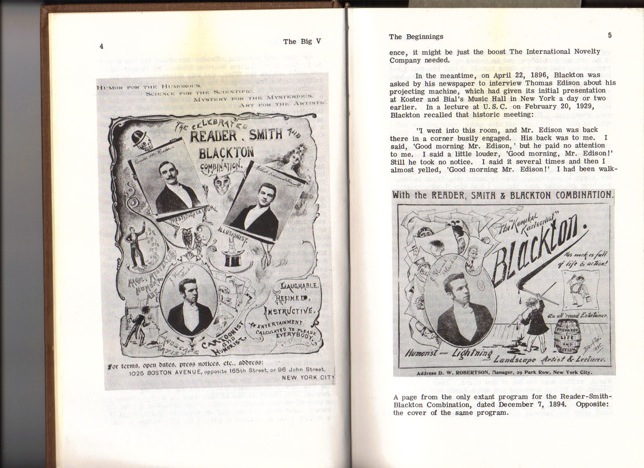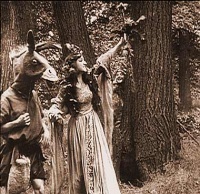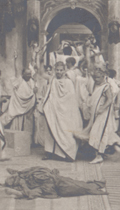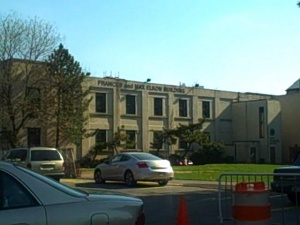Look to your right, Shulamith’s preschool you’ll see
But I wonder about that building and what it USED to be.
Before Shulamith brought it from Yeshiva University (YU),
It used to be a chem. lab. See, you’ve learnt something new!
But before that building held experiments galore,
It used to house costumes, props, scenery, and more!
The “factory” of the Vitagraph Company was there.
“What’s the ‘Vitagraph Company’?” “The factory of where?”…
Yup, there’re many questions, much you don’t yet know
But the answers are all there, we’ll just have to take it slow…
INTRODUCTION
Welcome to Shulamith High School, a place where I was lucky enough to spend many years of my life. When Professor Wills introduced her amazing idea for our Wiki Project in Seminar Two, namely: find a street whose history you are curious to know more about, my mind jumped to my alma mater. I mean, isn’t it only natural for me to desire to learn more about the history of the building which has provided me with multiple opportunities to take my own journeys into the past?
Though I knew the previous life of Shulamith was filled with mystery, romance, and intrigue, I didn’t know nearly how many treasures I would be able to uncover after diving into her tumultuous depths until I jumped. And now, I invite you to jump in with me, come on... the water's great.
First things first...
Let me tell you how to physically walk through the Shulamith School grounds.
Enter through the main gates (the ones that have YU HS embossed on them). If you did this properly, you’re in a tunnel. Walk through that tunnel, and you’ll end up on the gorgeous Shulamith campus. On either side of you now, is a big building. These two buildings are connected by a passageway (comprised, inside, of a gym and auditorium) located behind you. If you go into the building on your right, you’ll be in the preschool. If you enter the building on your left, you’ll end up bumping into elementary schoolers (on the first and second floors), middle schoolers (on the fourth floor), and high schoolers (on the third floor). In between the two structures is a grassy lawn-perfect for sun tanning or playing tag (our very own "quad," if you will). Beyond all the grass is a playground, usually occupied by many little preschoolers outside for their recess.
Here is a great arial view, in which we can notice the comparison between the Shulamith of today and the Vitagraph of yesteryear. (Rollover the picture to see who it's credited to)

Here We Go
This actual building was created in 1906, in the heart of a woodsy section in Brooklyn, the greatest borough in NYC. The site was picked because the buyers thought that the scenery would be just great for their purposes, and it was. J. Stuart Blackton and Albert E. Smith were about to open something that today, seems so commonplace, but back then was one of the first of its kind. A movie studio. A real, live movie studio.
In a patriotic attempt, the two British founders named their company American Vitagraph, and boy, did Vitagraph take off. As Anthony Slide records in his book, The Big V, “By 1912, Albert E. Smith wrote, Vitagraph ‘had 400 people in our stock company and quite a small army of photographers, printers, developers and other workers in different branches of the business’(2, 1987).” So many workers, just five years after Vitagraph opened its doors!
But I get ahead of myself, let us go back to the beginning.
THE FOUNDERS OF THE VITAGRAPH COMPANY OF AMERICA
J. Stuart Blackton was born on January 4, 1875, in Sheffield, England. He came to America as a child, where he started working, at the age of eleven or twelve, as the apprentice to a carpenter. During his spare time, however, he dreamt of working in show biz...
Albert E. Smith was born on June 4, 1875 in the English county of Kent, to a large family. When Smith was 13, his family came to America. Smith, too became apprenticed to a carpenter, amongst various other apprenticeships. He then, however entered show business as a magician. As Anthony Slide writes in The Big V, "An early playbill describes [Smith] as 'The Price of Entertainers, introducing original experiments in Prestidigitation, plus character impersonations, ventriloqual dialogues, and polyphonic imitations.'(34, 35)"
In 1894, these two men were introduced through a mutual friend named Ronald Reader, who had a feeling that his two friends, once put together, would be able to accomplish great things. Reader, Smith, and Blackton traveled together as "The International Novelty Company." They went around entertaining in fancy country-club-like places. They did magic, cartooning, and other fun things. After a while, though, their appeal kind of petered out, and they stopped doing their shows.
 [3]
[3]
In April of 1896, Blackton, who was, at the time, working for The New York Evening World, was sent to interview Mr. Thomas Alva Edison about the marvelous new invention, the kinetoscope, that Edison had just invented. This machine was able to record and play back motion! During the interview, Edison noticed Blackton, aka "The Komical Kartoonist", carrying a sketch pad, and asked Blackton if he could sketch him. Edison liked the sketch so much, that he invited Blackton out to the "Black Maria," Edison's private 'movie studio.' Together, Edison and Blackton created "The Enchanted Drawing;" the movie you are about to see. It is featured as being one of the (if not the) first examples of animated features in America.
The truth is, that much of what Blackton was doing was using "stop frame animation." This means they would stop the filming for a few seconds, change the frame, and begin filming again. This is not necessarily the same method used today, but it was an awesome starting point.
After doing this together, Blackton inquired about purchasing a kinetoscope machine, which he did in early 1897.
Smith and Blackton created a new partnership, and so began the famous Vitagraph Company.
So why did Blackton and Smith choose the name Vitagraph?
Anthony Slide records that the name was actually taken from Edison's "Vitascope." Blackton and Smith decided that Vita, which means "life", was a great name for their company. They added the word "graph" for its encompassing implications. As William Basil Courtney says, they "decided to adopt [Vitascope] with a more significant embellishment...Vitagraph, meaning life, picture, life portrayals. [4] At first, the newly developed motion picture technology just became another act in the Smith, Reader, and Blackton routine, to make it more interesting, and help them get back on their feet. But then, Smith and Blackton started getting involved in some motion picture advertising in late 1897. This led to film exhibition and and then to their interest in film production.
The first Vitagraph building was actually in Manhattan, and in that building, Blackton and Smith were able to film many short movies. But between 1898 and 1900, Edison began suing the partners, and it was agreed that Smith and Blackton would become Edison licensees. This meant that Edison would copyright all Vitagraph's films through 1900. But then, after a while, that contract dissolved because Edison would've closed them down, had they kept the Edison-Vitagraph agreement. That's when the American Vitagraph Company became its own, independent corporation.
William “Pop” Rock was added to the Vitagraph team by 1900, the year of Vitagraph’s incorporation. He was named President while Smith became Treasurer, and Blackton, Secretary. Rock was loud-mouthed, boisterous, diamond wearing, always cursing, yet more mature than his youthful counterparts.
After “Pop” Rock’s inauguration to the company, it was decided that there should be a separation between the production aspect of Vitagraph’s motion pictures, and the business of selling them. Rock was given control of the sales division, and he set up shop in Vitagraph’s Nassau Street offices. However, Blackton and Smith needed a place to produce. In August 1905, the Vitagraph Company began building on East 15th street and Locust Avenue, in the Flatbush area of Brooklyn. The land was very close to the “Brighton Beach elevated railroad” (what is today the Avenue M line, running the Q and the B), and this point became very useful (I will discuss why a little later).
The Building and More (The Part You've Been Waiting For)
The Views and Film Index for August 25, 1906 described the building process in depth. “The new factory… will be ready for occupancy about September 15. The cost of the building is $25,000.” The concrete block building was “supplied with a 100 horse-power engine which will operate a dynamo, to furnish electric light, heat, and power for the machine shop and dark room.” There were also special stages, and apparatus designed to “[take] novel pictures with special scenic effects.” The new Vitagraph factory also included roofs made of heavy duty glass which would “[diffuse] and intensi[fy] the rays of light so that the shadows are not perceptible.” (Slide, 12-14)
Vitagraph was also able to start producing night scenes in their new studio, and the in the Views and Film Index for December 22, 1906, it says “The Vitagraph Co. of America has been experimenting largely with high candle power electric light, to be used in connection with the taking of motion pictures. Their experts have now perfected a marvellously brilliant lamp by means of which film exposure can be made at night as well as during the day… (Slide,14)”
With the introduction of this new and magnificent building, came the ability to divide filming. All indoors shots were still filmed in the Nassau Street building, and this new Flatbush property was used to shoot the outdoor scenes.
Whenever both indoor and outdoor shooting needed to be done, the actors of those scenes would take all the props and things they’d need over to the Flatbush studio, making use of the Brighton line. William Shea, in the August 1915 issue of “Vitagraph Life Portrayals,” remarked, “It must have been some sight to see fifteen or twenty people get off a train, some carrying bundles and boxes with a sword or a spear sticking out, a little bit of a fellow struggling along with a suit of armor, and various other bulky properties distributed among the members of the party, but it was all part of the game.” After a while, though, the residents of the neighborhood got used to seeing the actors walking through the streets.
The first big picture taken in the Flatbush studios was Julius Caesar.
In fact, according to The Folger Shakespeare Library, Vitagraph was actually one of the companies that pioneered the filming of Shakespeare plays. [5]
Lest you think that bloopers are a modern day phenomenon, let me show you that the “pioneers” also encountered mistakes, albeit of a somewhat different nature. In the article mentioned above, William Shea anecdotally recalls how “During the taking of this picture a dog spoiled two hundred feet of film by walking into the scene during Anthony’s oration.”
Shea also lets us in on another secret. Shea reveals that, in those days, there were not even enough actors to go around. In fact, during the picture, "The Life of Washington", Shea played fifteen parts, “and in one scene—‘At Valley Forge’—I was compelled to die twice.(Slide, 14-15)”
Shea continued, saying that in those earlier days, if the actors of Vitagraph needed a special prop or piece of scenery, often they needed to make it themselves. “Frequently, when a picture was to be filmed, actors in costume came from all directions, with hammers, some with saws, others with paint brushes…In…”Romeo and Juliet,” the balcony scene was forgotten until the last minute, and the actor who was playing Romeo had to build his own balcony. (Slide, 15) ”
In 1908, Vitagraph opened a Paris office. By February 14, 1910, Vitagraph was releasing three reels of film a week, and the company’s profit in 1910 was over $600,000.
Vitagraph
TIMELINE FOR LOT #06735, BLOCK #0080 IN KINGS COUNTY, NEW YORK
This Building in Brief
Around 1907: The Vitagraph Company of America purchases the street in question and turns the farmland into one building complex.
1925: Warner Bros. buy the complex (and the company) and establishes "Vitaphone Co." to experiment with bringing sounds to movies.
1934-1959:Warner Bros. uses the studio for its Ace Field Laboratory.
Early 1960s:Yeshiva University (YU) buys the building.
1965:YU uses the grounds to house a boys high school and a girls one.
1980s:Shulamith School purchases the grounds.
A Deeper Discussion (The Beginning at the End)
Prologue: Though the Vitagraph Company had a major role to play in various places around the globe, such as Paris and California, throughout this report, I aim only to feature your attention on the rich history revolving around this particular Brooklyn building, and its pertaining history.
According to ACRIS: The New York City Department of Finance’s Office of the City Register; on February 1, 1982, Yeshiva University sold its property on East 14 Street and Avenue M to Shulamith School for Girls.
Yeshiva University had bought the building in the early 1960s from the Warner Bros. who had purchased it from the “veritable cradle of the film industry, ” The Vitagraph Company of America. As entrepreneurs in their field- the Vitagraph Company turned out to be silent movie experts. They had moved from Manhattan to Brooklyn in 1905, and according to Jenna Weissman Joselit, [6] "Vitagraph was the first of its competitors to erect a full-fledged movie studio, replete with laboratories, dressing rooms, administrative buildings, its very own water tank and a film stage whose newfangled glass roof, modeled after that of a conservatory, was the talk of the town. ”
Some of the major actors that performed for Vitagraph are John Bunny, Flora Finch, Kate Price, and Sydney Drew. Even Esther Williams performed a swimming spectacular on these Vitagraph grounds. Take that Brad Pitt!
The above actors performed in some awesome silent movies like A Tale of Two Cities, A Mid-Winter night’s dream/Little Joe’s Luck, Little Nemo, The Cure for Pokeritis , and A Vitagraph Romance(Sounds like the kinds of things that would sell nowadays. I guess some things just never change). I tried watching some of the clips, and it’s pretty cool how, if you look hard enough, you can even kind of read the actors’ lips. I guess that gave the characters an incentive to actually remember their lines, even though nobody ever really heard them!
("John Bunny and Flora Finch Released February 17, 1912 by Vitagraph Company of America" posted by 'bayougrande')
In 1925, Warner Bros. bought over the Vitagraph Company of America, and with it, this building in Flatbush. There, the Warner Bros. were able to produce many “shorts” (very short movies), and after a while, they were even able to introduce sound!
But as Weissman Joselit continues later, “In the end, Brooklyn was no match for Hollywood.”
In 1957, the movie studio closed, in part, due to the noisy subway and the din of the urban streets.
But in a way, that’s better for me. Because Vitagraph closed, Yeshiva University was able to buy the building and my mother was able to learn in the same school building I’ve had the privilege to spend many years of my life...
BIBLIOGRAPHY
Since a lot of the information I got overlapped from multiple sources, here is a general list of the sources I used (It will probably remain incomplete at least until the very last moment). Direct quotes are generally referenced (in the reference section below) individually.
And now, in no particular order, I present to you...
The Motion Picture Editors Guild
The New York Sun
Somebody's Research Project
Magictricks.com
Subway.com.ru
Animation World Magazine
Who's Who of Victorian Cinema
Thomas Santorelli
Encyclopedia Britannica
Katz's Film Encyclopedia
Silent Era
America's Story
SCREENonline
The International Movie Database
The Vitaphone Project
Dear Old Hollywood
Urbanography
NitrateVille
Absolute Astronomy.com
The History of Film
Vitagraph
Griffith, Richard. The Talkies, Dover Publications, Inc., New York 1971
Slide, Anthony. The Big V, The Scarecrow Press, Inc. Metuchen, N.J. & London. 1976, 1987
Crafton, Donald. The Talkies: American Cinema's Transition to Sound, Simon and Schuster Macmillan. New York 1997
REFERENCES
- ↑ http://www.inkwellimagesink.com/pages/articles/CentennialOfAmericanAnimation.shtml
- ↑ http://www.findagrave.com
- ↑ Slide, Anthony. The Big V, The Scarecrow Press Inc., 1976.
- ↑ Slide, Anthony. The Big V, The Scarecrow Press, Inc. Metuchen, N.J. & London. 1987. Page 7
- ↑ http://www.shakespeareinamericanlife.org/stage/hollywood/silentfilms.cfm
- ↑ Place and Time: When History Becomes an Asset
Wonders of America.
Published July 03, 2007, issue of July 06, 2007.
http://www.forward.com/articles/11078/
ACKNOWLEDGEMENTS
Thank you to everyone (and everything) that helped me with this project. The following is an incomplete list.
Thank you to Ron Hutchinson of the "Vitaphone Project" for answering my email promptly and efficiently!
Thank you to Patrick Breen of NBC for sitting with me and telling me what he knew.
Thank you to Google, YouTube, and Wikipedia.
ASKLAR
click me!!!









